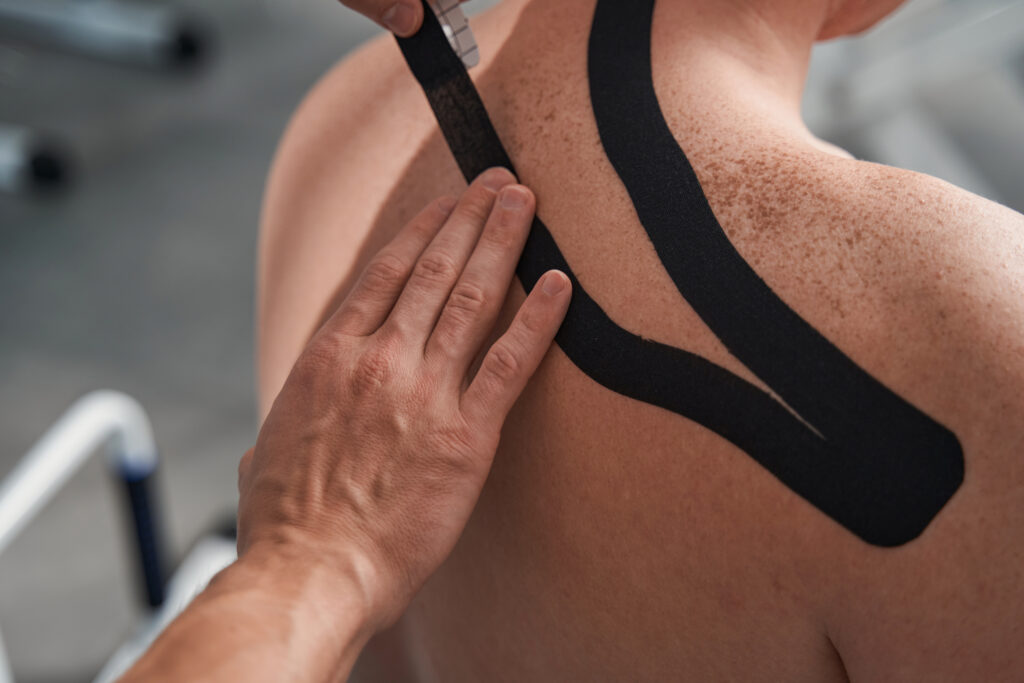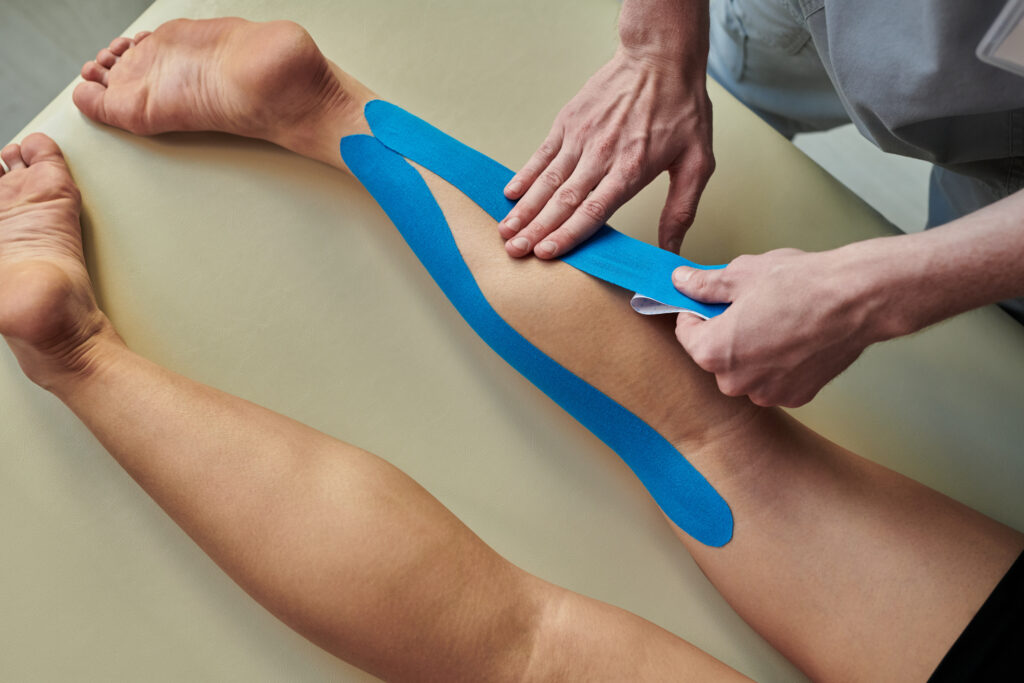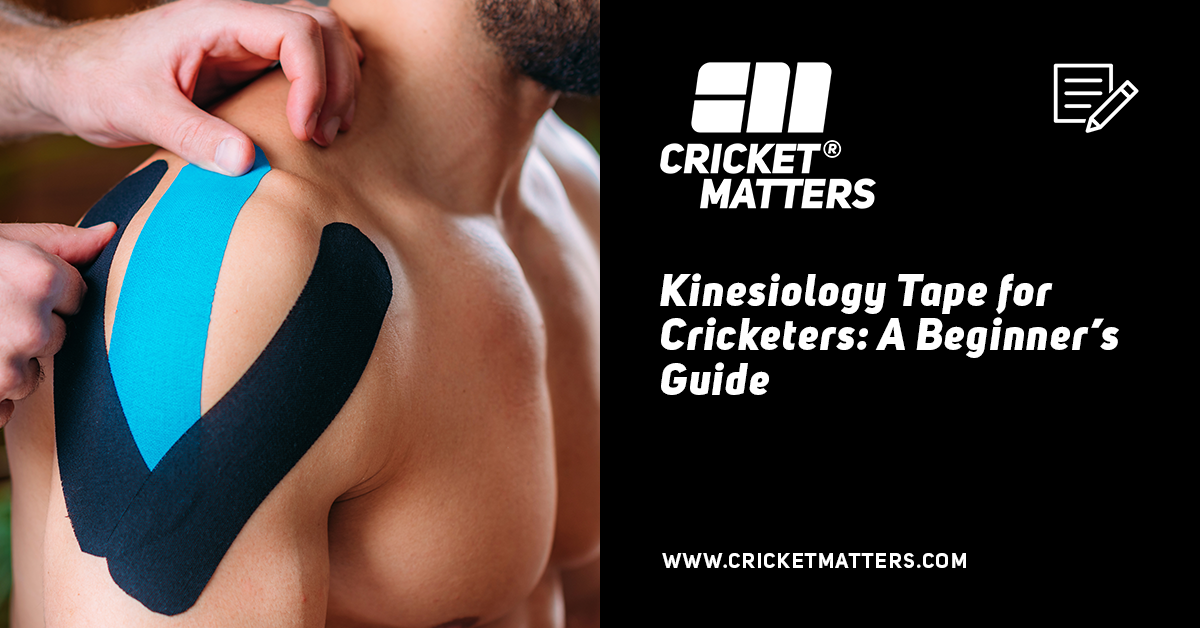
I hope you enjoy reading this blog post.
James Breese, Cricket Matters FounderIf you need my help with cricket coaching, strength and conditioning, injury rehab, or nutrition, click here.
You’ve noticed it — that strip of bright blue or neon pink running down a bowler’s shoulder, wrapping around a batter’s forearm, or stretching across a fielder’s calf. It’s all over cricket these days.
From England internationals to franchise players around the world, kinesiology tape has become part of the modern cricketer’s look — as common as compression sleeves or GPS vests.
And it’s not just used by professionals any longer. More club players are turning up with it too, often because they’ve seen someone on TV using it and thought, maybe that’ll help me as well.
But what does it actually do? Is it merely for show, or is there something more behind it?
In this guide, we’ll explain exactly what kinesiology tape is, how it functions, and how cricketers can use it to recover, move, and perform better — without falling into the trap of thinking it’s a magic fix.
Kinesiology tape isn’t a fix — it’s a feedback tool. It helps your body move better, not hide pain.
Table of Contents
What Is Kinesiology Tape — and What Does It Actually Do?

Kinesiology tape — or KT tape — is an elastic therapeutic tape designed to support muscles and joints without restricting their movement.
It was created in the 1970s by Japanese chiropractor Dr Kenzo Kase, who sought a method to protect injured tissue while enabling athletes to move freely. At that time, most sports taping was rigid and restrictive — excellent at stabilising an ankle, but not ideal for allowing a player to perform.
Fast forward a few decades, and kinesiology tape has become a staple in top-level sport — from Olympians and rugby internationals to, yes, professional cricketers. Its lightweight, stretchy design mimics the elasticity of human skin, so you can run, bowl, or swing the bat without feeling constrained.
Where traditional sports tape focuses on restriction, kinesiology tape offers support through movement. When applied correctly, it provides subtle feedback, increases awareness, and helps muscles perform more efficiently.
The Difference Between Kinesiology Tape and Sports Tape
It’s easy to mix up kinesiology tape with traditional sports tape — after all, they both come in a roll and both claim to provide “support.” But their mechanisms and the reasons for using them are entirely different.
Rigid sports tape focuses on restriction. It is designed to hold a joint or body part securely in place. You will see physios use it to strap up ankles, wrists, or fingers after an acute injury — something that needs protection from further movement. Its role is to provide stability and prevent motion, almost acting like a temporary brace. It’s excellent in the right situation — for example, when a player rolls an ankle mid-game and needs to complete the innings — but it’s not intended for long-term comfort or unrestricted movement.
Kinesiology tape, on the other hand, is about facilitation. It moves with the body. It stretches up to 140–180% of its length, providing gentle support while still allowing full range of motion. Rather than locking a joint down, it gives your nervous system a stream of feedback — helping muscles fire correctly, reducing excessive tension, and sometimes even helping with posture or movement awareness.
You can think of rigid tape as the brace that keeps you still when you’re injured. Kinesiology tape is the coach’s hand on your shoulder — light, guiding, and reminding your body how to move well again.
One protects movement. The other promotes it.
Used correctly, both have their place — it’s just about knowing which tool to use and when.
How Kinesiology Tape Works

At a basic level, kinesiology tape gently lifts the skin. That small amount of decompression helps improve blood flow, reduce pressure, and promote better lymphatic drainage—your body’s built-in waste removal system.
For cricketers, that can mean less swelling and tightness after long spells, double weekend matches, or heavy training blocks.
But there’s more to it than just circulation. The tape also interacts with your nervous system. Every time you move, the stretch and recoil of the tape send signals to your brain. That feedback enhances your awareness of movement — what physios call proprioception.
Think of it as a gentle reminder running across your skin, keeping you balanced, connected, and in control — especially when fatigue creeps in during the last overs of a long day in the field.
Then there’s the mechanical aspect. The direction and tension of the tape can subtly influence how a muscle activates or how a joint moves.
For example, taping around the shoulder can help stabilise the scapula and guide smoother rotation, while taping the lower back can provide additional feedback to maintain your posture through your movement and reduce back pain.
It’s not magic. But it’s clever.
Used well, kinesiology tape can help you:
- Manage pain from overuse or minor strain
- Improve movement awareness
- Support recovery between matches
- Reduce swelling and stiffness after long sessions
And crucially, it does all that without restricting you. You can bowl, bat, and field with it on.
What the Research Says
Research on kinesiology taping is inconsistent — and it’s important to be honest about that. Some studies show short-term benefits in pain, range of motion, proprioception, and swelling, while others see little difference compared to placebo.
But here’s what’s consistent: when kinesiology tape is used alongside proper strength work, mobility training, and rehab, players consistently report feeling better — looser, lighter, and more confident in their movement.
A few highlights from recent studies show:
- Improved pain management for common conditions like shoulder impingement, lower-back pain, and patellofemoral pain.
- Enhanced muscle control and joint stability during rehabilitation.
- Faster recovery and decreased swelling by improving lymphatic flow.
So no — kinesiology tape won’t make you bowl faster or hit further overnight. But it can help you feel better, move better, and recover more quickly — and in the long run of cricket, those small margins matter.
Kinesiology tape isn’t a fix. It’s a tool — one that bridges the gap between rehab and performance. Use it to support movement, not replace it.
Used correctly, kinesiology tape becomes the bridge between rehab and performance.
Why Cricketers Use Kinesiology Tape

Cricket is hard on the body. Long days in the field, hours at the crease, endless throwing and diving — it all adds up. By the end of a weekend, most players aren’t dealing with major injuries; they’re managing tightness, bruising, and the kind of niggles that never quite go away.
That’s where kinesiology tape comes in. It’s not there to hold you together — it’s there to help your body move and recover better.
After a heavy spell, bowlers often use it for shoulder stability and lower-back support, keeping them mobile through the next session.
Batters use it for feedback through the lead shoulder and wrists, or to take pressure off muscles that tighten from repetitive shots.
Keepers rely on it for long stints in a crouch, easing tension through the knees and back. And for fielders, it can help reduce swelling and soreness after those dives and sprints that leave their mark.
Even bruising — which every cricketer collects over a season — responds surprisingly well to taping. By gently lifting the skin, kinesiology tape helps improve local circulation and lymph flow, speeding up how quickly those deep-purple marks fade. It’s one of the simplest recovery tricks most players have never tried.
For deeper soft-tissue recovery between matches, many players also benefit from sports massage for cricketers — which complements the effects of kinesiology taping by improving circulation and easing post-match tension.
Real Example: My Shoulder and Neck
I use kinesiology tape myself, mainly on my right shoulder — the one that sits slightly lower after I broke my clavicle years ago. That small imbalance affects more than just its appearance; it influences how I move, rotate, and even how I see the ball when batting.
When I tape it, everything lines up better. My shoulder feels supported, but more importantly, my neck moves freely again. I can turn my head properly and stay balanced at the crease, which means I take my hands back higher and play the ball later.
It’s not about strength or restriction. It’s about feedback. The tape reminds my body where it should be and how to move efficiently.
It’s not about strength or restriction. It’s about feedback. The tape reminds my body where it should be and how to move efficiently.
That’s why we rely on kinesiology tape so frequently at the Cricket Matters Sports Injury & Performance Clinic. Not as a quick fix or a flashy addition — but as a practical, intelligent tool that enables cricketers to feel and perform at their best when it matters most.
When (and When Not) to Use It

Kinesiology tape is brilliant — but it’s not a miracle. Used properly, it can help you move better, recover faster, and feel more connected. Used wrong, it’s just expensive sticky paper.
When to Use It
Use kinesiology tape for performance and recovery — not to hide a problem.
It’s most useful when you’re:
- Managing load between matches — easing the strain after long weekends or tournament blocks.
- Recovering from a minor niggle — that tight hamstring or sore shoulder that needs support while you train or play.
- Improving body awareness — giving your muscles and joints subtle feedback to keep posture, rotation, or alignment in check.
- Reducing swelling or bruising — especially after taking a knock; it can help move fluid and speed up healing.
When used this way, tape becomes part of your performance plan — helping your body feel balanced and ready without getting in the way.
When Not to Use It
If you’re in pain, don’t reach for the tape first — find out why you’re in pain.
Pain isn’t normal. It’s your body’s way of saying something isn’t working properly.
Ignoring it and layering tape over the top doesn’t fix the problem; it just delays it.
We see it all the time — athletes (and the occasional stubborn runner) covered head-to-toe in tape, thinking it’ll solve everything. It won’t. If your shoulder hurts, your back’s locking up, or your knee keeps flaring, that’s a sign of a technical or movement issue that needs assessing — not hiding.
Avoid taping over:
- Sharp or persistent pain that lasts more than a few days.
- Injuries you haven’t had assessed.
- Open wounds, rashes, or allergies.
- The belief that tape replaces rehab, strength, or mobility work.
Kinesiology tape can guide movement, support recovery, and help you perform — but it won’t fix poor technique or bad habits.
If you’re in pain, get checked. If you’re moving well but need a little help between matches, tape up and get on with it.
Pain is a problem. Performance is the goal. That’s the difference.

Have You Downloaded Our FREE 7-Day Gym Workout Plan?
Grab your complete step-by-step 7-day gym workout plan for cricketers today. There will be no more Guesswork. Just follow the plan and get results.
Common Mistakes Cricketers Make with Kinesiology Tape

Kinesiology tape isn’t complicated, yet most players struggle to use it correctly. The difference between proper taping and poor application isn’t just in appearance — it’s in how it feels, how long it stays on, and whether it genuinely helps you move better. If done incorrectly, it peels off after the first session; done correctly, it quietly supports you for days.
Here’s where most cricketers go wrong.
#1 – Buying Cheap Tape That Doesn’t Hold Up
It’s simple to assume all tape is identical. It isn’t. The cheaper rolls you find online may seem convincing, but the adhesive fails the moment you sweat, dive, or spend hours in the field.
We’ve tested countless brands in the clinic and out on the pitch. The difference in quality is clear. At Cricket Matters, we use SPORTTAPE Pro, Tiger K Tape, and RockTape — the same tapes trusted across top-level sport. They cost more, but they last longer, grip more strongly, and are less likely to cause skin irritation.
Each player reacts differently to adhesives. That’s why we test which one works best for each client — not just what’s cheapest. A good tape should last you through a full weekend of cricket, not just the warm-up.
#2 – Neglecting Proper Skin Preparation
Tape doesn’t adhere to oil, sweat, or sun cream. It’s as straightforward as that. Yet, this is one of the main reasons players believe “the tape doesn’t work.”
Good taping begins before the roll even contacts the skin: clean, dry, and — if necessary — trimmed. It takes thirty seconds, but it’s the difference between tape that endures a match and tape that falls off by lunchtime.
#3 -Pulling Too Tight and Irritating the Skin
Most players make this mistake once. They assume tighter means better. It doesn’t. The tape works through elastic recoil, not tension.
Overstretching causes friction, irritation, and the opposite of what you want — a tape that lifts, blisters, and fails. The goal isn’t to strap yourself in; it’s to create movement awareness. Think guidance, not restriction.
#4 – Taping Over Pain Instead of Solving It
Pain is information. It’s not something to disregard, conceal, or silence with tape.
If you’re in pain, there’s a reason — a technical fault, a mobility issue, or a load imbalance. Covering it with tape doesn’t make you tough; it makes you reckless.
You’ve probably seen it — the stubborn runner covered head to toe, believing that more tape enhances performance. It doesn’t. If something hurts, find out why. Get assessed, move better, and then use tape as part of a solution — not as a cover-up for the problem.
#5 – Confusing Quantity with Quality
You don’t require half a roll to make an impact. Precision outweighs volume every time.
Well-applied tape follows anatomy, movement, and intent. It’s there to assist, not to decorate. A single well-placed strip that realises your shoulder or supports your lower back is worth more than a dozen random patterns taken from the internet.
When used correctly, kinesiology tape can help you feel stable, recover more quickly, and move more freely. Used carelessly, it’s simply expensive wallpaper.
At Cricket Matters, we view taping as part of a broader system — encompassing movement, strength, recovery, and education. Every strip we apply is intentional, based on assessment and understanding. The tape itself isn’t the answer. It acts as a link between how you move now and how you’ll perform in the future.
That’s the difference.
How We Use Kinesiology Tape at the Cricket Matters Clinic

At Cricket Matters, we don’t use kinesiology tape as decoration or because it “looks professional.” We use it with purpose — to manage pain, support recovery, and, most importantly, to enhance how our players move.
At Cricket Matters, every strip of tape we apply is intentional — based on assessment, not aesthetics.
Every application begins with an assessment. Whether it’s a full SFMA screen, a movement analysis, or an in-person cricket assessment, we start by identifying what’s genuinely limiting performance. The tape only goes on once we understand the pattern.
From there, it becomes part of a larger plan — integrated with manual therapy, soft-tissue work, mobility drills, and strength training. It’s not the fix; it’s the link between the treatment room and performance in the middle.
We use kinesiology tape for three main reasons:
1. Pain Management and Recovery
For players with minor niggles — such as a stiff shoulder, tight hamstring, or bruised calf from a misfield — tape can help soothe the area and speed up recovery between sessions. It lifts the skin slightly, enhancing circulation and alleviating the stress on irritated tissues so the body can settle and heal naturally.
2. Technical Feedback and Movement Awareness
This is where it becomes impactful. We use taping not just to treat pain, but to teach movement.
A simple example: a batter unable to rotate their neck fully. Without proper cervical rotation, they cannot align their shoulders correctly, so they open their stance, adjust their head position, and change their bat path — all because of a mobility issue. A small strip of tape across the upper back or neck can help them sense that restriction, cue proper alignment, and improve their movement during training.
The same principle applies to fast bowlers. When the thorax locks up and the serratus anterior feels as if it’s glued to the ribs, rotation becomes limited. That leads to compensations further down the chain — overloading the lumbar spine, hips, and even the front leg on landing. With the right taping strategy, we can provide tactile feedback that helps the bowler “find” that lost movement again, reinforcing it through mobility and strength work.
It’s a teaching tool — not a bandage.
3. Integrated Coaching and Conditioning
Kinesiology tape is most effective when integrated into a comprehensive coaching system. During strength or technical drills, it helps reinforce posture, shoulder control, or breathing mechanics — especially in the serratus anterior and trunk stabilisers. Over time, this fosters new awareness that extends into performance.
If you’re curious whether taping could help your game, book a screening at our Sports Injury & Performance Clinic. We’ll show you exactly how to use it properly — and just as importantly, when not to.
Used with purpose, kinesiology tape isn’t about colour or comfort. It’s about connection — between body, movement, and performance.
That’s the difference between treatment and coaching. That’s Cricket Matters.
Final Word: Kinesiology Tape for Cricketers

Kinesiology tape has become part of modern cricket, but not for the reasons most people believe. It isn’t there to support you or to give a professional appearance. It’s designed to help your body remember proper movement — to regain alignment, rhythm, and confidence when fatigue, overuse, or pain start to interfere.
Used correctly, it serves as a bridge — between the clinic and the crease, between what you can feel and what you can control. It handles load, enhances awareness, and allows your nervous system to relearn proper movement patterns. It doesn’t replace strength training, mobility, or skill; it boosts the benefits of all three.
But it also requires honesty. If you’re reaching for tape to mask pain, you’re missing the point. Pain is information. It’s a message that something upstream or downstream isn’t functioning properly — a technical fault, a mobility restriction, a stability issue. Tape can guide you towards better movement, but it can’t fix what you refuse to confront.
At Cricket Matters, we use it as part of a system — assess, treat, move, coach. It’s never the main focus, but it’s a useful supporting element in helping cricketers stay healthy, consistent, and able to perform when it counts most.
Because that’s the real goal: longevity. The ability to keep playing the game you love, year after year, without the constant battle against your own body.
Better Every Ball isn’t just a slogan; it’s a philosophy. It embodies the belief that improvement is always within reach — not via shortcuts, but through awareness, consistency, and care.
Tape smart. Train smarter. And never stop investing in the one thing that truly matters in this game — your body.
Evidence Corner: What the Research Says
Kinesiology tape (KT) has gained traction in both clinical and athletic settings, particularly for pain management, proprioception, and post-exercise recovery. While its exact physiological mechanisms remain debated, research generally supports its role as a complementary tool — not a standalone solution. When integrated with proper rehab or strength work, KT may help athletes feel more stable, reduce swelling, and improve movement awareness.
What It Does Well
- Pain Reduction: KT has been shown to modestly reduce pain in musculoskeletal conditions such as shoulder impingement, patellofemoral pain, and lower back discomfort when used alongside standard therapy (Montalvo et al., 2014; Labianca et al., 2022).
- Enhanced Proprioception: Several studies demonstrate improvements in proprioception, particularly at the knee and shoulder, especially in individuals with existing proprioceptive deficits (Ager et al., 2023; Kielė & Solianik, 2023).
- Swelling and Edema Relief: KT can support lymphatic drainage and reduce post-injury swelling, particularly in cases of acute trauma or intense activity (Li et al., 2024).
- Improved Functional Recovery: KT may accelerate recovery from delayed-onset muscle soreness (DOMS) and improve postural alignment when combined with movement retraining (Kirmizigil et al., 2019).
Where It Falls Short
- Variable Results on Performance: KT does not consistently enhance objective performance measures like speed, strength, or power. Any perceived benefits often relate to confidence or comfort rather than biomechanics (Williams et al., 2012).
- Short-Term Effects: Benefits in proprioception or pain may be short-lived without concurrent rehab — lasting only while the tape is worn (Ahmed, 2021).
- Not Effective for All Populations: Evidence is mixed for healthy individuals with no proprioceptive deficit; benefits appear greater in injured or recovering athletes (Hosp et al., 2015).
What This Means for Cricketers
Cricketers dealing with mild overuse injuries, post-match tightness, or posture-related movement issues may benefit from KT as part of a wider support strategy. It’s not a fix for poor technique or chronic pain — but when applied properly, it can help guide awareness, reduce discomfort, and support recovery between matches. The key is to use tape with purpose — guided by assessment, not aesthetics.
Key Research References
- Montalvo, A. M., Cara, E. L., & Myer, G. D. (2014). Effect of kinesiology taping on pain in individuals with musculoskeletal injuries: Systematic review and meta-analysis. The Physician and Sportsmedicine. https://doi.org/10.3810/psm.2014.05.2057
- Ager, A. L., de Oliveira, F. C. L., Roy, J. S., & Borms, D. (2023). Effects of elastic kinesiology taping on shoulder proprioception: A systematic review. Brazilian Journal of Physical Therapy. https://doi.org/10.1016/j.bjpt.2023.100492
- Kielė, D., & Solianik, R. (2023). Four-week application of kinesiotaping improves proprioception, strength, and balance in individuals with ACL rupture. The Journal of Strength and Conditioning Research. https://doi.org/10.1519/JSC.0000000000004371
- Li, Y., Xia, Y., Zhang, D., Fu, S., Liu, M., & Pan, X. (2024). Immediate effect of kinesiology taping on muscle strength, static balance and proprioception after eccentric muscle fatigue. BMC Musculoskeletal Disorders. https://doi.org/10.1186/s12891-024-07365-6
- Labianca, L., Andreozzi, V., & Princi, G. (2022). Effectiveness of kinesio taping in improving pain and edema during ACL rehab. Acta Bio Medica. https://doi.org/10.23750/abm.v92iS1.11917
- Kirmizigil, B., & Chauchat, J. R. (2019). Effectiveness of kinesio taping in recovering from delayed onset muscle soreness: A crossover study. Journal of Sport Rehabilitation. https://doi.org/10.1123/jsr.2018-0357
- Williams, S., Whatman, C., Hume, P. A., & Sheerin, K. (2012). Kinesio taping in treatment and prevention of sports injuries: A meta-analysis. Sports Medicine. https://doi.org/10.2165/11594960-000000000-00000
Bottom line for cricketers:
When used with purpose, kinesiology tape can support recovery and movement — but it’s not a shortcut for rehab, coaching, or strength work.
Further Reading
FAQ
Can I Apply Kinesiology Tape Myself, or Should It Be Done by a Physio?
You can apply kinesiology tape yourself for straightforward areas such as the forearm or calf, provided you understand the correct direction and tension. However, tape is most effective when guided by assessment. For complex regions like the shoulder, back, or neck, professional application makes a difference. A physio or qualified coach can identify which structures actually need support and how taping integrates with movement patterns. Many players are shown how to self-apply once the right technique is established. The key is understanding why you’re taping before worrying about how.
How Long Should I Leave Kinesiology Tape On After Training or Matches?
Most kinesiology tapes are designed to stay on the skin for three to five days. They should remain secure through showers, sweat, and normal movement. If the tape begins to peel or cause irritation, remove it immediately rather than trying to re-stick it. Prolonged wear beyond five days offers no extra benefit and can increase the risk of skin reaction. The goal is to allow the tape to assist recovery between sessions—not to become a permanent fixture. Always give your skin time to breathe before reapplying.
When Should Cricketers Not Use Kinesiology Tape?
Cricketers should avoid kinesiology tape when pain is sharp, persistent, or unexplained. Tape can help manage load and awareness, but it does not treat underlying injury. It should never replace medical assessment or structured rehabilitation. Avoid using tape over open wounds, rashes, or areas of skin irritation, and discontinue use if redness or itching develops. Most importantly, don’t use tape to mask problems. Pain in the shoulder, back, or knee during bowling or batting usually indicates a movement or workload issue that needs addressing first.
Does Kinesiology Tape Improve Bowling Speed or Power?
There is no reliable evidence that kinesiology tape directly increases bowling speed or striking power. Its role is to support movement quality, not to boost force production. Where it may help indirectly is by improving proprioception—your body’s awareness of position and motion—and reducing fatigue or discomfort that restricts performance. If a bowler can maintain better posture, rotation, and timing through reduced pain or tension, output may improve slightly. But the tape itself doesn’t make you faster; sound technique, conditioning, and recovery do.
Which Kinesiology Tapes Are Best for Cricketers?
Quality matters more than brand name. The best tapes for cricket are those that remain adhesive through heat, sweat, and long match days. In the UK, SPORTTAPE Pro, Tiger K Tape, and RockTape are among the most reliable, offering consistent elasticity and strong hypoallergenic glue. Cheaper options often peel quickly or irritate the skin. That said, personal response to adhesives varies—what sticks well for one player may not suit another. The ideal tape is comfortable, durable, and holds without causing irritation across full days in the field.

Have You Downloaded Our FREE 7-Day Gym Workout Plan?
Grab your complete step-by-step 7-day gym workout plan for cricketers today. There will be no more Guesswork. Just follow the plan and get results.



